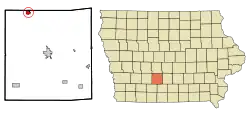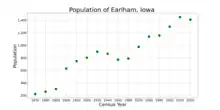Earlham, Iowa
Earlham[lower-alpha 1] is a city in Madison County, Iowa, United States. The population was 1,410 at the time of the 2020 census.[4] It is part of the Des Moines–West Des Moines Metropolitan Statistical Area.
Earlham, Iowa | |
|---|---|
| Motto: "Plant roots. See them grow."[1] | |
 Location of Earlham, Iowa | |
| Coordinates: 41°29′35″N 94°7′25″W | |
| Country | |
| State | |
| County | Madison |
| Area | |
| • Total | 0.94 sq mi (2.45 km2) |
| • Land | 0.94 sq mi (2.45 km2) |
| • Water | 0.00 sq mi (0.00 km2) |
| Elevation | 1,102 ft (336 m) |
| Population (2020) | |
| • Total | 1,410 |
| • Density | 1,492.06/sq mi (576.37/km2) |
| Time zone | UTC-6 (Central (CST)) |
| • Summer (DST) | UTC-5 (CDT) |
| ZIP code | 50072 |
| Area code | 515 |
| FIPS code | 19-23340 |
| GNIS feature ID | 0456104 |
| Website | The Community of Earlham Iowa Website |
History
David Hockett brought his wife, Mary Jane, and three children to the Earlham area by ox team and wagon in 1865. They settled on 200 acres where Earlham stands today. By deeding a land string to the Chicago, Rock Island and Pacific Railroad and selling a third of his acres for town development in 1969, Hockett was instrumental in the founding of Earlham, when it was incorporated on April 26, 1870.[5] The city was named after Earlham College, a Quaker college in Richmond, Indiana.[6]
Geography
Earlham is located at 41°29′35″N 94°7′25″W (41.493137, -94.123661).[7]
According to the United States Census Bureau, the city has a total area of 0.97 square miles (2.51 km2), all of it land.[8]
Demographics
| Year | Pop. | ±% |
|---|---|---|
| 1870 | 222 | — |
| 1880 | 260 | +17.1% |
| 1890 | 302 | +16.2% |
| 1900 | 630 | +108.6% |
| 1910 | 749 | +18.9% |
| 1920 | 803 | +7.2% |
| 1930 | 897 | +11.7% |
| 1940 | 865 | −3.6% |
| 1950 | 771 | −10.9% |
| 1960 | 788 | +2.2% |
| 1970 | 974 | +23.6% |
| 1980 | 1,140 | +17.0% |
| 1990 | 1,157 | +1.5% |
| 2000 | 1,298 | +12.2% |
| 2010 | 1,450 | +11.7% |
| 2020 | 1,410 | −2.8% |
| Source:"U.S. Census website". United States Census Bureau. Retrieved March 29, 2020. and Iowa Data Center Source: | ||

2010 census
As of the census[10] of 2010, there were 1,450 people, 544 households, and 389 families living in the city. The population density was 1,494.8 inhabitants per square mile (577.1/km2). There were 571 housing units at an average density of 588.7 per square mile (227.3/km2). The racial makeup of the city was 98.3% White, 0.1% African American, 0.5% Asian, 0.2% from other races, and 0.9% from two or more races. Hispanic or Latino of any race were 0.8% of the population.
There were 544 households, of which 41.9% had children under the age of 18 living with them, 59.2% were married couples living together, 8.5% had a female householder with no husband present, 3.9% had a male householder with no wife present, and 28.5% were non-families. 24.8% of all households were made up of individuals, and 10.5% had someone living alone who was 65 years of age or older. The average household size was 2.67 and the average family size was 3.22.
The median age in the city was 34.3 years. 31.6% of residents were under the age of 18; 6.2% were between the ages of 18 and 24; 30.3% were from 25 to 44; 20.8% were from 45 to 64; and 11.2% were 65 years of age or older. The gender makeup of the city was 50.0% male and 50.0% female.
2000 census
As of the census[11] of 2000, there were 1,298 people, 491 households, and 352 families living in the city. The population density was 1,336.9 inhabitants per square mile (516.2/km2). There were 520 housing units at an average density of 535.6 per square mile (206.8/km2). The racial makeup of the city was 99.31% White, 0.15% African American, 0.08% Native American, and 0.46% from two or more races. Hispanic or Latino of any race were 0.62% of the population.
There were 491 households, out of which 39.1% had children under the age of 18 living with them, 61.9% were married couples living together, 7.7% had a female householder with no husband present, and 28.3% were non-families. 24.8% of all households were made up of individuals, and 13.8% had someone living alone who was 65 years of age or older. The average household size was 2.59 and the average family size was 3.11.
Age spread: 29.5% under the age of 18, 7.1% from 18 to 24, 32.7% from 25 to 44, 17.4% from 45 to 64, and 13.3% who were 65 years of age or older. The median age was 33 years. For every 100 females, there were 95.5 males. For every 100 females age 18 and over, there were 91.4 males.
The median income for a household in the city was $42,917, and the median income for a family was $54,519. Males had a median income of $32,262 versus $24,896 for females. The per capita income for the city was $20,659. About 0.9% of families and 3.8% of the population were below the poverty line, including 1.8% of those under age 18 and 5.4% of those age 65 or over.
Education
Earlham is served by the Earlham Community School District.
Notes
- /ˈɜːrləm/[3]
References
- "The Community of Earlham Iowa". The Community of Earlham Iowa. Retrieved September 2, 2012.
- "2020 U.S. Gazetteer Files". United States Census Bureau. Retrieved March 16, 2022.
- Sherman, Barney (September 14, 2017). "Iowa Place Names: A-E". Iowa Public Radio. Retrieved June 16, 2021.
- "2020 Census State Redistricting Data". census.gov. United states Census Bureau. Retrieved August 12, 2021.
- "Earlham, Iowa". City-Data.com. Retrieved September 2, 2012.
- "Profile for Earlham, Iowa, IA". ePodunk. Retrieved September 2, 2012.
- "US Gazetteer files: 2010, 2000, and 1990". United States Census Bureau. February 12, 2011. Retrieved April 23, 2011.
- "US Gazetteer files 2010". United States Census Bureau. Archived from the original on July 2, 2012. Retrieved May 11, 2012.
- "Census of Population and Housing". Census.gov. Retrieved June 4, 2015.
- "U.S. Census website". United States Census Bureau. Retrieved May 11, 2012.
- "U.S. Census website". United States Census Bureau. Retrieved January 31, 2008.
External links
- The Community of Earlham Iowa Website Portal style website, Government, Business, Library, Recreation and more
- City-Data.com Comprehensive Statistical Data and more about Earlham